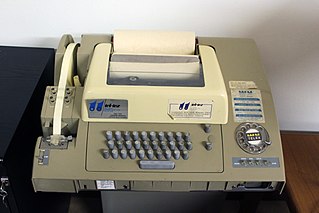The People's Republic of China possesses a diversified communications system that links all parts of the country by Internet, telephone, telegraph, radio, and television. The country is served by an extensive system of automatic telephone exchanges connected by modern networks of fiber-optic cable, coaxial cable, microwave radio relay, and a domestic satellite system; cellular telephone service is widely available, expanding rapidly, and includes roaming service to foreign countries. Fiber to the x infrastructure has been expanded rapidly in recent years.
Packet Switch Stream (PSS) was a public data network in the United Kingdom, provided by British Telecommunications (BT). It operated from the late 1970s through to the mid-2000s.

Swisscom AG is a major telecommunications provider in Switzerland. Its headquarters are located in Worblaufen near Bern. The Swiss government owns 51% of Swisscom. According to its own published data, Swisscom holds a market share of 56% for mobile, 50% for broadband and 37% for TV telecommunication in Switzerland. Its Italian subsidiary, FASTWEB, is attributed 16% of private clients and 29% of the corporate clients share of Italian broadband and is also active in the mobile market.
A softswitch is a call-switching node in a telecommunications network, based not on the specialized switching hardware of the traditional telephone exchange, but implemented in software running on a general-purpose computing platform. Like its traditional counterparts it connects telephone calls between subscribers or other switching systems across a telecommunication network. Often a softswitch is implemented to switch calls using voice over IP (VoIP) technologies, but hybrid systems exist.
Network switching subsystem (NSS) is the component of a GSM system that carries out call out and mobility management functions for mobile phones roaming on the network of base stations. It is owned and deployed by mobile phone operators and allows mobile devices to communicate with each other and telephones in the wider public switched telephone network (PSTN). The architecture contains specific features and functions which are needed because the phones are not fixed in one location.
System X is the digital switching system installed in almost all telephone exchanges throughout the United Kingdom, from 1980 onwards.

Teletex was ITU-T specification F.200 for a text and document communications service that could be provided over telephone lines. It was rapidly superseded by e-mail; however, the name Teletex lives on in several of the X.500 standard attributes used in Lightweight Directory Access Protocol.

Telekom Malaysia Berhad or simply TM is a Malaysian telecommunications company founded in 1984. Beginning as the national telecommunications company for fixed line, radio, and television broadcasting services, it has evolved to become the country's largest provider of broadband services, data, fixed line, pay television, and network services. TM ventured into the LTE space with the launch of TMgo, its 4G offering. TM's 850 MHz service was rebranded as unifi Mobile in January 2018.
DX 200 is a digital switching platform currently developed by Nokia Networks.

A network processor is an integrated circuit which has a feature set specifically targeted at the networking application domain.

The Overseas Telecommunications Commission (OTC) was established by Australia in August 1946. It inherited facilities and resources from Amalgamated Wireless Australasia (AWA) and Cable & Wireless, and was charged with responsibility for all international telecommunications services into, through and out of Australia. In effect, all overseas telecommunications was nationalized. Australia was adopting a Commonwealth-wide policy that had been adopted at the Commonwealth conference in 1945. The main goal was to end the artificial routing of traffic to cable or wireless depending on private financial profits.
In voice telecommunications, least-cost routing (LCR) is the process of selecting the path of outbound communications traffic based on cost. Within a telecoms carrier, an LCR team might periodically choose between routes from several or even hundreds of carriers. This function might also be automated by a device or software program known as a least-cost router.
Stored program control (SPC) is a telecommunications technology for telephone exchanges. Its characteristic is that the switching system is controlled by a computer program stored in a memory in the switching system. SPC was the enabling technology of electronic switching systems (ESS) developed in the Bell System in the 1950s, and may be considered the third generation of switching technology. Stored program control was invented in 1954 by Bell Labs scientist Erna Schneider Hoover, who reasoned that computer software could control the connection of telephone calls.

GeoNet was an early international online services network built using microcomputers. Based on the software developed in Germany by GeoNet Systems GmbH in the early 1980s, and completed in the early 1990s, it was one of the first networks to offer a comprehensive online services platform, and was early to market with a number of innovations. Unlike other "mailbox" systems at the time, GeoNet had a user-friendly command interface and made extensive use of distributed processing technology.
CT2 is a cordless telephony standard that was used in the early 1990s to provide short-range proto-mobile phone service in some countries in Europe and in Hong Kong. It is considered the precursor to the more successful DECT system. CT2 was also referred to by its marketing name, Telepoint.
The GTD-5 EAX is the Class 5 telephone switch developed by GTE Automatic Electric Laboratories. This digital central office telephone circuit switching system is used in the former GTE service areas and by many smaller telecommunications service providers.

Telex is a telecommunication service that provides text-based message exchange over the circuits of the public switched telephone network or by private lines. The technology operates on switched station-to-station basis with teleprinter devices at the receiving and sending locations. Telex was a major method of sending text messages electronically between businesses in the post–World War II period. Its usage went into decline as the fax machine grew in popularity in the 1980s.












